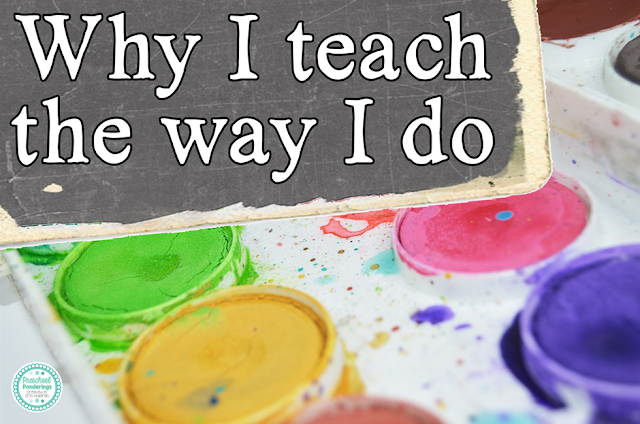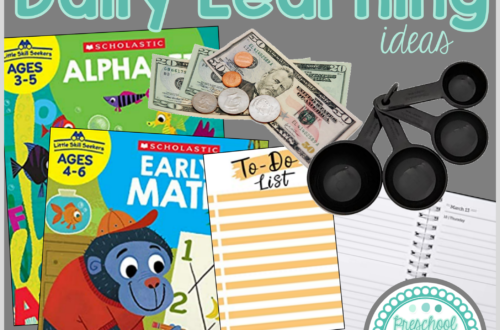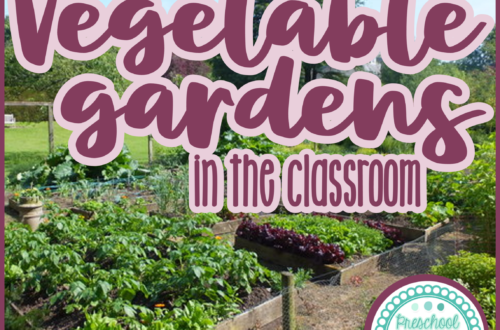My personal philosophy
One of my favorite Early Childhood blogs is Let the childrenplay. I love it because Jenny’s educational philosophies are so closely aligned with my own – she has great love for loose parts, hands on learning, and getting messy! She posted this week about the big ideas behind her philosophies, and why she connects with each of them (you can read it all here). Her post got me thinking about the philosophies that I value, and more importantly, why I value them.
I’ve shared many of my values related to education here, but I’m not sure that I’ve ever written about why these particular methods and ideals resonate with me. I think now, as we’re all thinking about a new school year, is the perfect time to revisit and reflect. So here are the big picture kinds of things that I value in early childhood education – and why:
Sensory learning experiences
I almost typed hands-on learning there, but I changed my mind, because getting your hands into materials is great, but I’ve seen children learn – really learn – from experiences where they got to use more than just their hands. I think that the best learning experiences are those that stimulate multiple senses. Children should have opportunities to smell new smells, and hear new noises, and connect these smells and noises to what they are seeing and feeling at the same time. When my toddlers were fascinated with coffee, the entire project started with smell, and many of them made the connection that it was something they had smelled at home. Those experiences lead to deeper understanding.
Making standards meaningful
I am grateful to have a set of standards guiding my practice, but I believe that standards are there to help me provide focus to the things that the children are already curious about. I could list a hundred different ways to introduce size sequencing, but my students really got the concept when we explored different sized marshmallows while engaged in a camping investigation. The marshmallows were relevant to topic that really truly interested them, so they were motivated to explore them and I was able to help them focus on a concept that was developmentally appropriate.
Authentic learning
Authentic learning comes in the form of real-life experiences. When my students wanted to know where ants lived, we didn’t turn to Google immediately, we went outside and looked for them ourselves. When the children determined that they must live underground then we had to do a little more research from additional sources to see how they lived underground, and what those underground spaces looked like, but this information added to the understanding that they created by following the ants.
Whole language environments
This fits closely with authentic learning. I strongly believe that children should be surrounded by words – but more importantly that there should be specific reasons for those words to be displayed. Vocabulary should be related to children’s interests, teachers should write down the things that children say, and children’s writing should be displayed the same way that we display their artwork.
Process art
Art shouldn’t be about talent or skill, art should be about expressing yourself and enjoying the creative process. I’ve had students look at my drawing and say “I can’t draw like you do Ms. Erin” and I remind them that I have had a lot more time to practice, but then I always remind them that all that really matters is how much fun they have doing it. I don’t want to show a child something that I made and expect their finished piece to look exactly like mine, I want to celebrate differences and encourage children to try new things.
It’s been a long time since I’ve thought really critically about the way I teach, and how strongly I feel about all of this, I need to take time to reflect on specific practices more often!
I almost typed hands-on learning there, but I changed my mind, because getting your hands into materials is great, but I’ve seen children learn – really learn – from experiences where they got to use more than just their hands. I think that the best learning experiences are those that stimulate multiple senses. Children should have opportunities to smell new smells, and hear new noises, and connect these smells and noises to what they are seeing and feeling at the same time. When my toddlers were fascinated with coffee, the entire project started with smell, and many of them made the connection that it was something they had smelled at home. Those experiences lead to deeper understanding.
Making standards meaningful
I am grateful to have a set of standards guiding my practice, but I believe that standards are there to help me provide focus to the things that the children are already curious about. I could list a hundred different ways to introduce size sequencing, but my students really got the concept when we explored different sized marshmallows while engaged in a camping investigation. The marshmallows were relevant to topic that really truly interested them, so they were motivated to explore them and I was able to help them focus on a concept that was developmentally appropriate.
Authentic learning
Authentic learning comes in the form of real-life experiences. When my students wanted to know where ants lived, we didn’t turn to Google immediately, we went outside and looked for them ourselves. When the children determined that they must live underground then we had to do a little more research from additional sources to see how they lived underground, and what those underground spaces looked like, but this information added to the understanding that they created by following the ants.
Whole language environments
This fits closely with authentic learning. I strongly believe that children should be surrounded by words – but more importantly that there should be specific reasons for those words to be displayed. Vocabulary should be related to children’s interests, teachers should write down the things that children say, and children’s writing should be displayed the same way that we display their artwork.
Process art
Art shouldn’t be about talent or skill, art should be about expressing yourself and enjoying the creative process. I’ve had students look at my drawing and say “I can’t draw like you do Ms. Erin” and I remind them that I have had a lot more time to practice, but then I always remind them that all that really matters is how much fun they have doing it. I don’t want to show a child something that I made and expect their finished piece to look exactly like mine, I want to celebrate differences and encourage children to try new things.
It’s been a long time since I’ve thought really critically about the way I teach, and how strongly I feel about all of this, I need to take time to reflect on specific practices more often!


